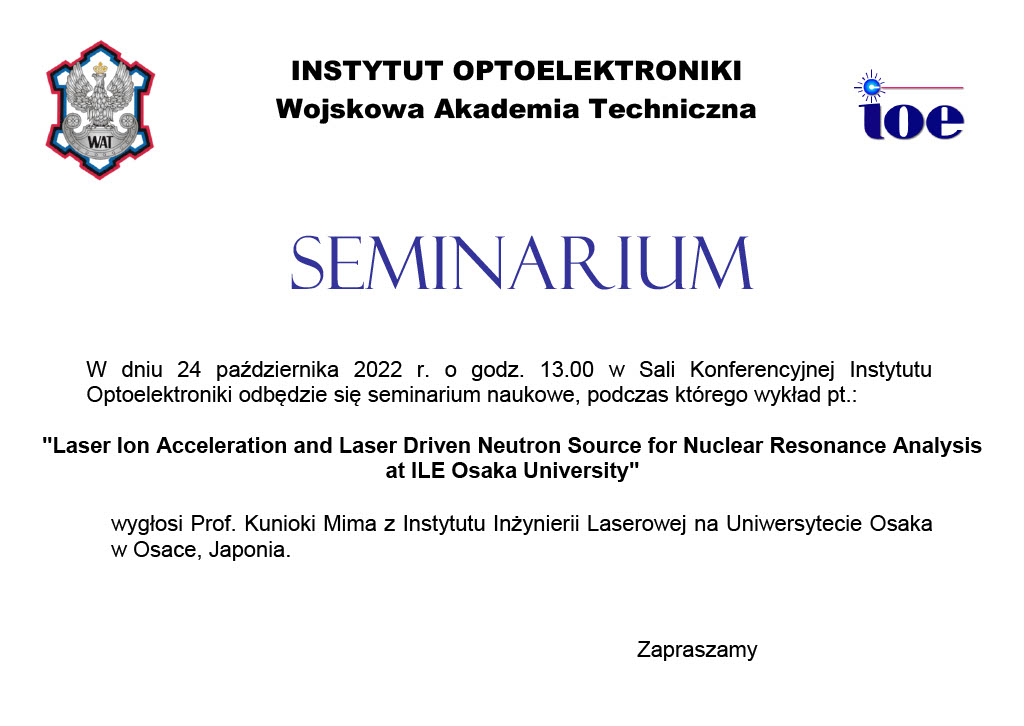Szanowni Państwo,
w dniu 24 października 2022 r. o godz. 13:00 w Sali Konferencyjnej Instytutu Optoelektroniki odbędzie się seminarium naukowe, podczas którego wykład pt.:
„Laser Ion Acceleration and Laser Driven Neutron Source for Nuclear Resonance Analysis at ILE Osaka University”
wygłosi prof. Kunioki Mima z Instytutu Inżynierii Laserowej na Uniwersytecie Osaka w Osace, Japonia.

______________________________________________________________________________
Researches on Laser Ion Acceleration and Laser Driven Neutron Source for
Nuclear Resonance Analysis at ILE Osaka University
Kunioki Mima
ELI-Beam-Line, Czech Republic
(On leave from Institute of Laser Engineering, Osaka University, Japan)
I start with brief introduction of the present status of Institute Laser Engineering (ILE) of Osaka University. Then, the topics on Laser Driven Ion Acceleration (LDIA) and Laser Driven Neutron Source (LDNS) researches at ILE are presented.
Since early 1990’s, various schemes of LDIA are investigated as one of the applications of the intense short-pulse-laser interaction with plasmas [1]. The LDIA has been applied for radiography, medical application, neutron source and so on. In this seminar, I overview the researches at ILE Osaka Univ. on LDIA, laser driven neutron ource (LDNS) [2] and its application to nuclear resonance absorption (NRA) [3].
The LDNS is unique because the number of neutrons per micro pulse is very large and the source size and the pulse width are small. Therefore, the extensive research and development of LDNS are going on in the world. A scheme of LDNS (Pitcher- catcher) by the LDIA is described, which is the Pitcher-Catcher Scheme (PCS). The characteristics of the LDNS by PCS are compared with those of the accelerator driven neutron source (ADNS). Then, I explain a unique application of LDNS such as the nuclear resonance absorption (NRA) imaging. Namely, by the LDNS, the NRA imaging is possible with a relatively short beam line in comparison with that of the ADNS, since the neutron pulse width and the source size of LDNS are small. The future prospect of the R&D of the NRA imaging with LDNS [4] is also discussed.
[1] A. Macchi, P.59-P.92, Chap.5 Laser Driven Ion Acceleration, “Application of Laser-Driven
Particle Acceleration”, Edited by P.R. Bolton, K. Parodi, and J. Schreiber, CRC press, Taylor &
Francis Group, 2018, (M. Borghesi will present this topic on LDIA in this seminar.)
[2] Lancaster, K.L., Karsch, S., Habara, H., et al., Characterization of 7Li(p,n)7Be neutron yields
from laser produced ion beams for fast neutron radiography, Physics of Plasmas, 11.3404(2004)
[3] S. Kar, A. Green, H. Ahmed, A. Alejo, A.P.L. Robinson, M. Cerchez, R. Clarke, D. Doria,
S. Dorkings, J. Fernandez, S.R. Mirfayzi1, P. McKenna5, K. Naughton1, D. Neely2, P. Norreys2,6,
C. Peth3, H. Powell, J. A. Ruiz, J. Swain, O. Willi and M. Borghesi, “Beamed neutron emission
driven by laser accelerated light ions” New J. Phys. 18, 053002 (2016).
[4] A.Yogo, et al., “Laser-driven neutron generation realizing single-shot resonance
Spectroscopy”, to be published in PRX, 2022.

